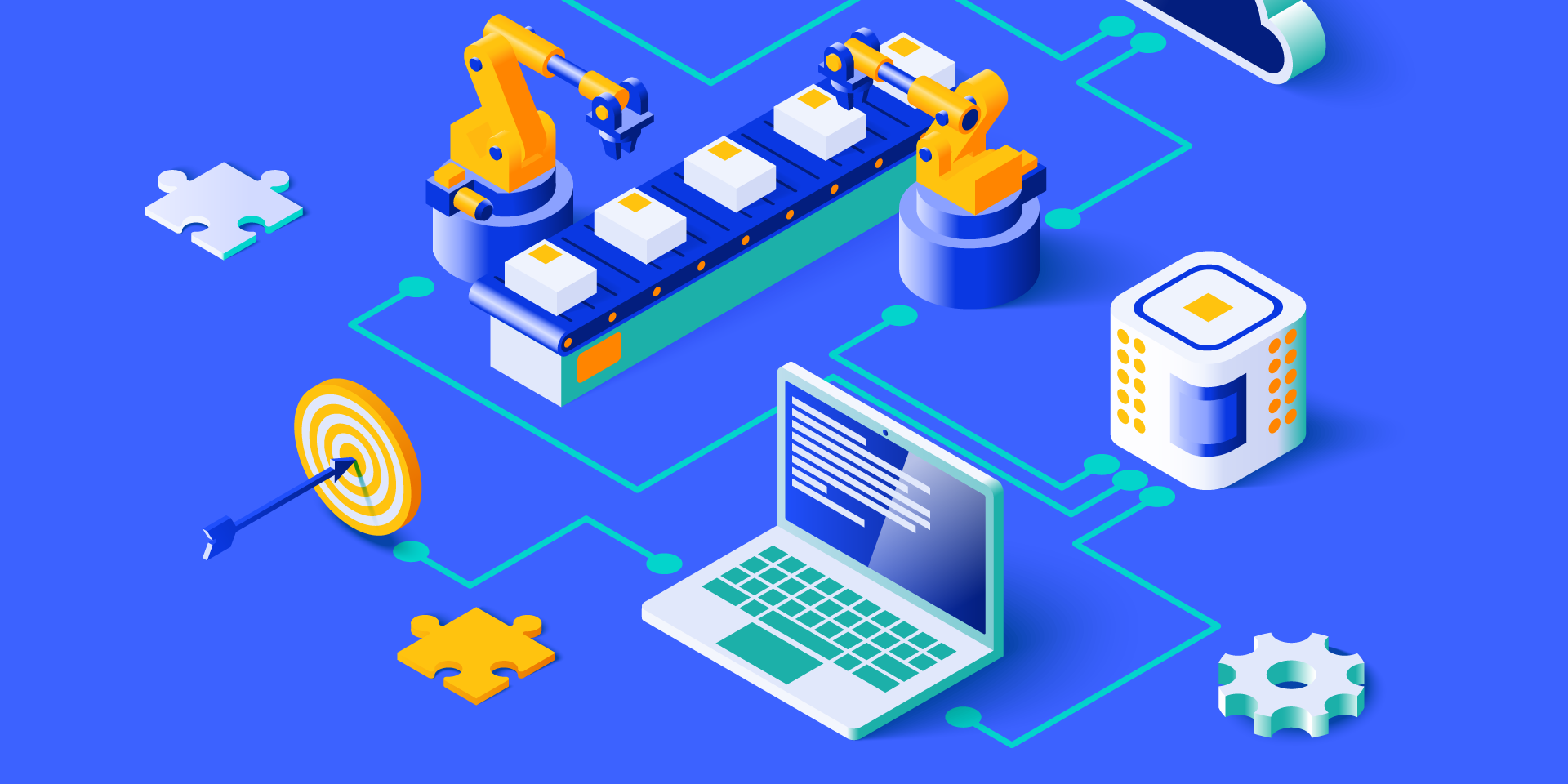There’s no denying it. Requests for Proposals (RFPs) are complicated.
As a way for buyers to evaluate vendors for large contracts, RFPs typically include hundreds—sometimes thousands—of questions that need to be answered in a short timeframe. It’s a recipe for stressed out sales teams—unless you can find a way to answer these requests efficiently.
This is why RFP software has become an essential tool for high-performing teams over the past five years. It help you finish responses more efficiently, while improving proposal quality—no matter how tight the deadline.
According to the 2021 RFP Response Trends Report, 69% of teams use a dedicated RFP tool to streamline their work. If you’ve never used this tool before, you may have questions about what it is and how it works. So in this article, you’ll learn answers to the frequently-asked questions about RFP software.
1. What is RFP Software?
Commonly used by proposal managers, sales, or security teams, RFP software simplifies the process of responding to RFPs, requests for information (RFIs), due diligence questionnaires (DDQs), and more.
RFP software typically includes the following functions:
- Storing and organizing commonly used information
- Searching and automatically filling in answers
- Providing a collaborative workspace for team projects
Overall, teams that use an RFP solution are able to provide accurate answers every time, finish RFPs faster, and more effectively engage teammates to improve responses.
2. What does RFP software do?
RFP software stores and organizes the information that’s commonly used in a searchable library. It also makes it easy to add new content to your answer library once a project is complete. Most importantly, it provides a single-source of truth for answers, that’s always up-to-date (which is much better than searching through email threads for RFP answers).
It also acts as a collaborative digital workspace that makes it easier to track project status, edit documents, streamline communication, and speed up handoffs between subject matter experts (SMEs) who are contributing to the RFP.
Lastly, RFP tools can automatically fill in answers by pulling content from past proposals into new projects. (Only takes a couple of clicks, just like magic. 🪄)
3. How do I start the RFP process using software?
There’s three main ways to start the RFP process using software:
- Start a new project within your RFP software. You’ll set key dates to keep the assignment on track (including team kickoff and submission date). Then, you’ll import the RFP itself into the project.
- Begin answering the RFP questions through a portal. In a separate tab from your bid portal, open up your RFP software. Then, search your library to find the content you need and paste those answers below each portal question.
- Start a project from your Customer Relationship Management (CRM) tool. You can also start a new RFP project directly within a CRM like Salesforce. Go to the account associated with this opportunity, then select the ‘new project’ button to kickoff an RFP and fill out the fields pictured below.
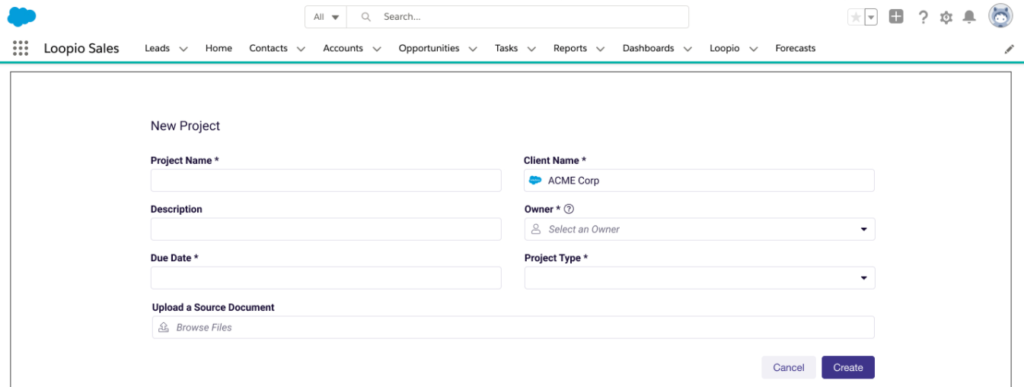
Pictured above: Example of how to start an RFP project in Salesforce, using Loopio’s RFP software.
4. How do you write an RFP answer using software?
There are two main ways to write an RFP answer using software:
- Write the answer manually and collaborate with reviewers. As you’re working within an RFP project, type your answer into the box below each question. Then, assign a subject matter expert to review (and validate) that response.
- Use RFP automation to pull in previously written answers. If you use a software that has automation capabilities, it can save time by automatically populating answers by pulling content from your library. Entries in your library can be used to answer repetitive RFP questions over and over again.
5. How much does RFP software cost?
RFP software typically comes in a range of prices, depending on the number of features, users, or projects required.
Most vendors provide a variety of pricing plans. But the average ones will range from the essentials (like unlimited projects and automation capabilities) to enterprise plans that are custom-built for global organizations with unique needs.
Tip: be sure to ask if there are extra charges for services like support or onboarding that will better enable your team.
6. Can you visualize RFP metrics in charts and graphs using software?
Yes, you can typically visualize RFP metrics through charts and graphs found on the homepage of your RFP platform. Dashboards should provide a high-level overview of the status of your tasks, project volume, and progress, so you can easily see a bird’s eye view of your team’s work.
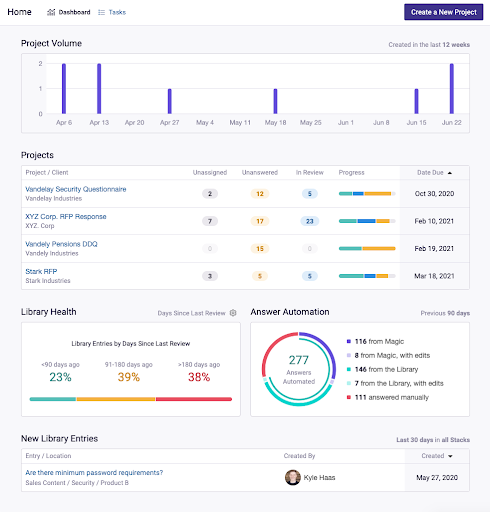
Pictured above: Example of dashboards in Loopio’s RFP response software.
RFP platforms can also be connected to other platforms to share data and build custom reporting. For example, syncing with your customer relationship management platform to track revenue per proposal.
7. What is RFP automation?
RFP automation helps create consistent, quality responses—no matter how tight your deadlines or how many proposals you’ve got to tackle.
Key automation features include:
- Filling in the blanks with one click. Tools can find and suggest the right answers.
- Easy way to start new projects. Some softwares can auto-detect questions, to help you kickstart your responses even faster. (No more scrolling from section-to-section.)
- Formatting fixes. Cut-back on formatting errors through smart tools that easily export an RFP into a custom, branded template.
- Automated review cycles. Set content reviews to an automated cadence, so no one forgets to update vital product information.
8. Can I automatically answer an RFP?
Yes, RFP software can automatically suggest the right answer to a proposal question. It does this by pulling responses from your content library through natural language processing (a subset of artificial intelligence) that determines answer accuracy.
The secret is to set-up a library that’s well-organized so your software knows exactly which answer to auto-populate into each project. (We’ll get to that next.)
9. How should I organize my RFP content library?
To build a RFP library that’s easy to use, you need a consistent and organized structure. Most proposal software will organize your content through stacks and categories, which puts your answers into intuitive buckets for better searchability.
Stacks should sort your product or service information into the broadest possible topics. Start by thinking about who needs to access them. Then, use categories to drill down further into the topics that belong under each stack.
Below is an example of how to organize your content by stack, then split that up into smaller categories and subcategories.

Pictured above: Template to organize your content in an RFP library.
10. How can I make my content searchable?
Content search is often based on keywords. However, adding tags can help teams find specific content in their library even faster. In the search bar of your RFP library, try filtering your search results against specific tags.
Common tags include:
- Geography
- Vertical
- Short/long-form answers
- NDA requirements
11. How do I know if my RFP answer is up-to-date?
Some RFP solutions provide information on when an answer was last updated. This will help you know if your content was recently modified—or in need of a refresh.
To decide if content is relevant to your current proposal, you can also view what projects it was recently used in.
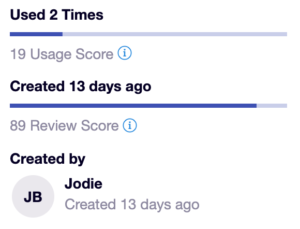
Pictured above: Example of how to tell if an answer is up-to-date using Loopio’s RFP tool.
12. How can I store attachments for an RFP?
The best response solutions have an attachment library that allows you to store different graphs, charts, and pictures that can be added to your RFPs. Each of these files can be attached to an answer itself or to the final exported document.
Files that can typically be uploaded to RFP software include PDFs, documents, excel spreadsheets, image files, GIFs, and powerpoint presentations.
13. How can I migrate data to an RFP software?
Migrating data can be done using an import function within your RFP tool. Simply set-up an Excel file with all of your questions in one column and corresponding answers in the next. Then, upload that file to your new platform.
If you don’t have the internal people power to set-up this master document, ask your vendor if they have professional services available to speed up the process.
14. How do I organize my RFP content in bulk?
Using an excel spreadsheet, you can upload several thousand answers into an RFP software platform in one fell swoop. Look out for solutions that have no limit to the amount of content you can store on that platform.
If you’re organizing your library by tags, categories, and subcategories, be sure to include that on your spreadsheet when you upload your RFP content.
15. How can I audit RFP answers for changes?
Every new entry to your RFP content library should contain an audited trail of activity in a detailed change log.
Examples of tracked activities include: when an answer was created, last updated, and last reviewed.
16. Can I manage my RFP library in more than one language?
Some RFP softwares are built to handle multiple languages. This function is used most-frequently by global proposal teams who are producing proposals across several geographies.
The best content libraries will provide the same advanced search functionality across all languages that their platform supports. You can easily find RFP answers by filtering content via language labels.

Pictured above: Loopio’s Multi-Language Library
17. How can I export a project from RFP software?
Once your project is complete and you’re ready to export the document, there are a few ways to go about it. If you’re dealing with a word document, you can export the project back into its original file.
This creates a submission-ready proposal without spending unnecessary time and effort on formatting. Or, to really help you stand out from the competition, you can also export a proposal into custom templates with your company’s branding.
18. What other tools should I sync to RFP software?
In the sales cycle, there’s three critical tools that seriously speed up your work through RFP software. One is your customer relationship management (CRM) tool, which assigns proposals to upcoming revenue opportunities. The second is a sales enablement platform for insights into your prospect’s behaviour. The last is an instant messaging tool, for quick and efficient communication with your team.
Best in class tools to sync with RFP software are:
- Salesforce for CRM
- Seismic for sales enablement
- Slack for instant messaging
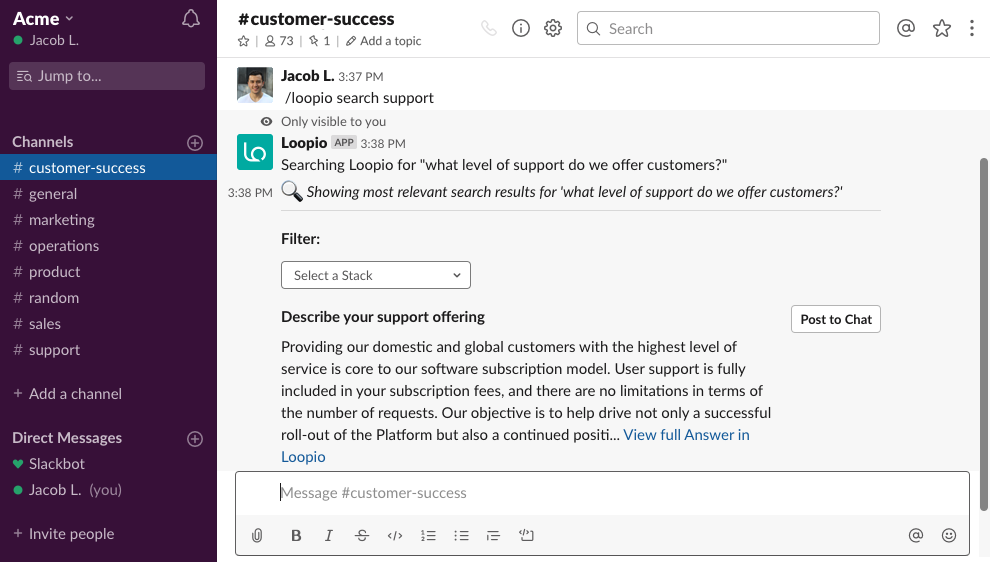
Pictured above: Loopio’s Slack integration.
19. How will our SMEs get notified if they are needed to review or answer a question?
Another benefit of implementing RFP response software is that your team will be able to support complex review workflows.
This includes automatically alerting reviewers when they’ve been assigned a question and sending them warnings when a due date is approaching.
20. Can I limit user access to my sensitive RFP content?
Yes, some RFP platforms offer robust permissions that can enable you to manage which content users can view or edit.
User roles and permissions can typically be changed through an Administrators (Admin) panel.
In this Admin Panel, you may also have the opportunity to define custom groups for your users, which can make it easier to change in bulk. Some examples of groups include “InfoSec”, “Proposal Writer”, or “Product Managers”.
21. Can I track of multiple documents like RFIs, Security Questionnaires in one project?
You can typically store multiple documents required for a prospect in one project. This will help you keep track of the progress for all documents in one place before making your final submission. For example: monitoring how many questions have been answered in your security questionnaire vs. the RFP.
Storing these in one project also makes it easy to assign the same SMEs for consistency across documents. This way you can have one core team focused on all the prospect’s needs.
22. How can I structure my proposal process?
There are six key steps to set up a successful proposal process:
- Assess if you should respond to an RFP using a go/no-go decision template.
- Create a project roadmap. Import the proposal to your software of choice, then assign dates for key milestones in the process.
- Use your content library to fill-in answers you already have on hand.
- Enlist your SMEs to help fill-in answers you don’t have. Do this by tagging them on individual questions in your RFP software.
- Take a final pass for editing. Once you’ve proofread the response, assign your executive stakeholder to do a final review.
- Export your RFP and submit it to your prospect.
23. How do you convince SMEs to adopt a new tool?
Get buy-in by engaging SMEs in the following ways:
- Talk to key business sponsors to establish alignment around training processes and goals across different teams.
- Next, engage your influencers and early adopters. Influencers get people into the platform; early adopters give you feedback.
- Lastly, gather feedback from end-users about how they’d like to be trained and what they’d like to learn.
